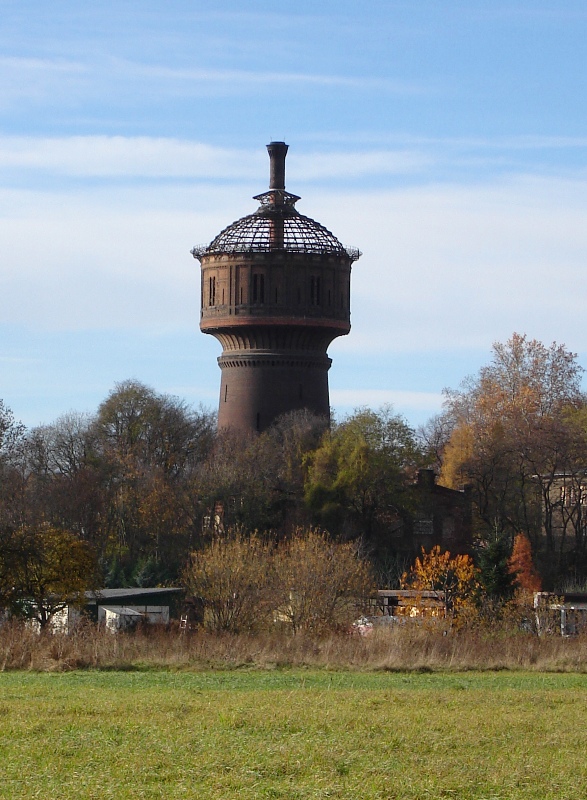Intze Principle on:
[Wikipedia]
[Google]
[Amazon]
The Intze Principle () is a name given to two engineering principles, both named after the
 A water tower built in accordance with the Intze Principle has a brick shaft on which the water tank sits. The base of the tank is fixed with a ring anchor (''Ringanker'') made of iron or steel, so that only vertical, not horizontal, forces are transmitted to the tower. Due to the lack of horizontal forces the tower shaft does not need to be quite as solidly built.
This type of design was used in Germany between 1885 and 1905.
A water tower built in accordance with the Intze Principle has a brick shaft on which the water tank sits. The base of the tank is fixed with a ring anchor (''Ringanker'') made of iron or steel, so that only vertical, not horizontal, forces are transmitted to the tower. Due to the lack of horizontal forces the tower shaft does not need to be quite as solidly built.
This type of design was used in Germany between 1885 and 1905.
File:Intze 1.jpg, Intze 1 tank
File:Intze 1b.jpg, Intze 1 tank with inside cylinder
File:Intze 2.jpg, Intze 2 tank
 The method of
The method of ''Talsperren nach dem Intze-Prinzip''
at www.kuladig.de. Retrieved 15 Nov 2017.
Otto Intze and water tower construction
Hydraulic engineering Water towers Dams
hydraulic engineer
Hydraulic engineering as a sub-discipline of civil engineering is concerned with the flow and conveyance of fluids, principally water and sewage. One feature of these systems is the extensive use of gravity as the motive force to cause the move ...
, Otto Intze, (1843–1904). In the one case, the ''Intze Principle'' relates to a type of water tower; in the other, a type of dam.
Intze Principle for water towers
 A water tower built in accordance with the Intze Principle has a brick shaft on which the water tank sits. The base of the tank is fixed with a ring anchor (''Ringanker'') made of iron or steel, so that only vertical, not horizontal, forces are transmitted to the tower. Due to the lack of horizontal forces the tower shaft does not need to be quite as solidly built.
This type of design was used in Germany between 1885 and 1905.
A water tower built in accordance with the Intze Principle has a brick shaft on which the water tank sits. The base of the tank is fixed with a ring anchor (''Ringanker'') made of iron or steel, so that only vertical, not horizontal, forces are transmitted to the tower. Due to the lack of horizontal forces the tower shaft does not need to be quite as solidly built.
This type of design was used in Germany between 1885 and 1905.
Intze Principle for dams
 The method of
The method of dam
A dam is a barrier that stops or restricts the flow of surface water or underground streams. Reservoirs created by dams not only suppress floods but also provide water for activities such as irrigation, human consumption, industrial use, aqua ...
construction invented by Otto Intze was used in Germany at the end of the 19th and beginning of the 20th centuries. A dam built on the Intze Principle has the following features:
* it is a gravity dam
A gravity dam is a dam constructed from concrete or stone masonry and designed to hold back water by using only the weight of the material and its resistance against the foundation. Gravity dams are designed so that each section of the dam is ...
with an almost triangular cross-section
* the wall is made of rubble stone
Rubble masonry or rubble stone is rough, uneven building stone not laid in regular courses. It may fill the core of a wall which is faced with unit masonry such as brick or ashlar. Some medieval cathedral walls have outer shells of ashlar wit ...
with a high proportion of mortar
* it has a curved ground plan
* it has facing brickwork (''Vorsatzmauerwerk'' or ''Verblendung'') on the upper part of the upstream side
* it has an earth embankment against the lower part of the upstream side, the so-called Intze Wedge (''Intze-Keil'')
* it has a cement-sealed upstream face, coated with a layer of bitumen
Bitumen ( , ) is an immensely viscosity, viscous constituent of petroleum. Depending on its exact composition, it can be a sticky, black liquid or an apparently solid mass that behaves as a liquid over very large time scales. In American Engl ...
or tar
Tar is a dark brown or black viscous liquid of hydrocarbons and free carbon, obtained from a wide variety of organic materials through destructive distillation. Tar can be produced from coal, wood, petroleum, or peat. "a dark brown or black b ...
* it has internal vertical drainage
Drainage is the natural or artificial removal of a surface's water and sub-surface water from an area with excess water. The internal drainage of most agricultural soils can prevent severe waterlogging (anaerobic conditions that harm root gro ...
using clay pipes behind the upstream face
The purpose of the Intze Wedge is to provide an additional seal in the area of the highest water pressure. During the 1920s, this type of construction was gradually superseded by concrete dams or arched dams which were cheaper to build.at www.kuladig.de. Retrieved 15 Nov 2017.
See also
* List of dams in GermanyReferences
External links
Otto Intze and water tower construction
Hydraulic engineering Water towers Dams